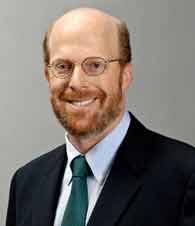|
Executive Interviews: Interview with Daniel Levinthal on Learning Organizations
July 2008
-
By Dr. Nagendra V Chowdary
 Daniel Levinthal
Daniel Levinthal Reginald H Jones Professor of Corporate Strategy at the Wharton School, University of Pennsylvania, Current Chair of the Management Department at Wharton. 
Should companies make any perceptible
changes to their organizational
structures to be successful
learning organizations? Any new hierarchical
arrangements and reporting
structures to be made?
Broader sorts of experimentation is facilitated
by relatively decentralized
structures. If you want an organization
to sustain a high level of variety
in its approaches, it is hard to do so
with a highly centralized resource allocation
system. Indeed, firms such
as Google that are noted for high levels
of discovery allow their professional
staff to allocate a modest fraction
of their time to projects of their
own initiative.
|
|
One is to become a (successful)
learning organization. Other is to be
benefited from being a learning organization.
However, how do we assess
whether an organization has become
truly a learning organization or not?
Are there any yardsticks to assess the
attainment of being a learning organization?
For simple first order learning processes
of refining the firm's existing
practices, there are the standard sort
of benchmarks such as learning
curves and other measures of rates of
improvement. The challenge is more
difficult to measure rates of learning
with respect to higher order learning
processes that involve more basic
changes in the firm's way of doing
business or productmix. With regard
to product development activity, one
standard metric is to track what fraction
of existing sales are represented
by products or services introduced in
a recent time window, such as the last
five years. A more subtle sort of measure
relates to the fact that firms that
are committed to learning are committed
to identifying and surfacing failures.
Is the organization tracking in a
rich and full ways, its record of failures
as well as successes? What is the role of leadership in creating
a successful learning organization?
Leadership is critical in setting the
tone for the broader organization.
Does the leader buy into the ethos of
continuous improvement for him or
herself, or simply expect that of others?
Does the leader provide a context
in which people feel safe in surfacing
issues and problems that might guide
useful changes in practices or is this
potentially useful data going to be repressed
out of fear that their jobs and
evaluation will be threatened? Should the concept of a learning organization
be looked at as a competitive
necessity or amere organizational
nicety?
Business firms need to continually
improve and adapt if they are to survive
and be competitively viable over
any sustained period of time. The
days of sheltered markets and the
easy life of the quiet monopolist are
long gone. Indeed, given any competitive
positionwill likely erode over
time, it has been argued that the only
truly sustainable competitive advantage
a firm might have is the ability to
adapt and to learn. It's more than 35 years
since Chris Argyris propounded
the idea of learning in organizations.
What new evidence, if at all, do
you find in support of learning organizations?
What does the latest
research has to say on learning
organizations?
Well, first, the idea in fact precedes
Argyris and arguably first entered the
management andorganizational literature
with the work of James March
and Herbert Simon in the 1950s. The
issue of organizational learning is one
of the more active lines of inquiry
within the management literature. A
major focus of current work is how
organizations manage to balance the
dual imperative of exploiting their
current knowledge (leveraging and
diffusing the existing set of superior
practices) and exploring new, alternative
bases of action. A vibrant system
needs to do both. An organization
that focuses excessively on the former
will do well in the short run but in a
longer horizon is likely to find itself at
a competitive disadvantage. An organization
that overinvests in exploration
may not do sufficiently well in
the near term to survive to see the
fruits of these exploratory efforts. As
March and I argue in a paper entitle,
"The Myopia of Learning", exploitive
activity tends to drive out exploratory
efforts. The payoffs to more
exploitive efforts are more certain,
closer in time, and more proximate to
the actors involved. How organizations
can maintain an appropriate
mix, what structures facilitate this,
and what in fact comprises an appropriate
mix are important topics of ongoing
research efforts.
1.
Learning Organizations Case Study
2. ICMR
Case Collection
3.
Case Study Volumes
|
The Interview was conducted by Dr. Nagendra V Chowdary, Consulting Editor, Effective
Executive and Dean, IBSCDC, Hyderabad. This Interview was originally published in Effective Executive, IUP, July 2008. Copyright © July 2008, IBSCDC
No part of this publication may be copied, reproduced or distributed, stored in a retrieval
system, used in a spreadsheet, or transmitted in any form or medium electronic,
mechanical, photocopying, recording, or otherwise without the permission of IBSCDC. |
